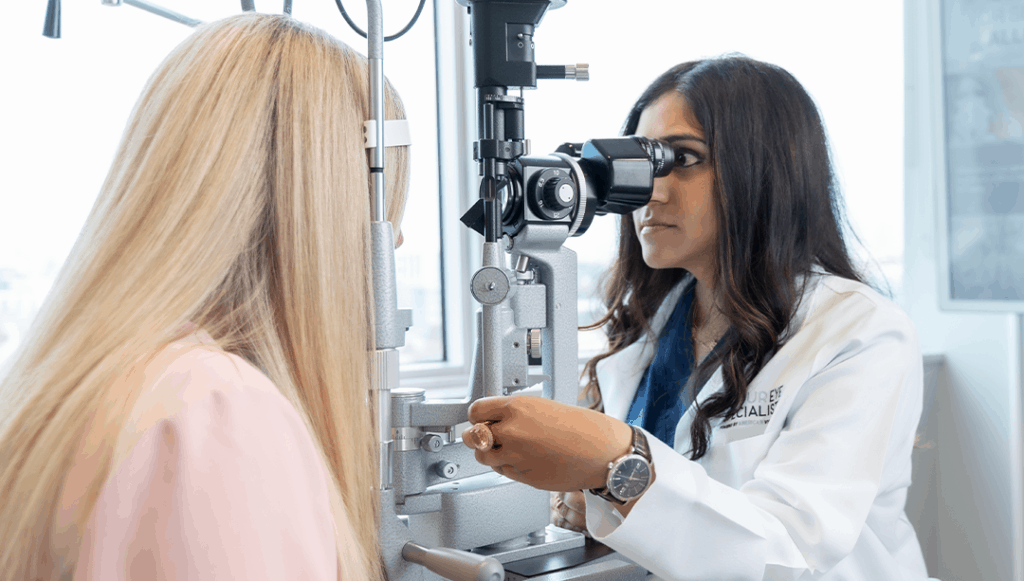Retina Disorder
The retina is a thin layer of light-sensitive tissue that lines the back of the eye. It is located near the optic nerve.
Light rays are captured by the retina and transmitted to the brain where they are interpreted as images. The retina processes a picture from the focused light, and the brain is left to decide what the picture is.

What Is a Retina Disorder?
There are a variety of eye conditions that affect the retina. Below we will explain some of the most common retina disorders, including macular degeneration and diabetic retinopathy, along with the treatment options that will be available to you at Your Eye Specialists. Contact us today for more information if you have any questions not answered by the guide below.
Anyone who has experienced retinal detachment understands the emergency situation it entails. The reason for this emergency is due to the thin layer of tissue (retina) near the back of the eye that is pulled apart from its usual position. Detachment itself entails a separation of the retinal cells from a layer of blood vessels that provide oxygen and further nourishment to the eye. The longer the retinal detachment occurs, the higher the risk of permanent vision loss and infection.
There are various causes of retinal detachment, including:
- A sagging vitreous – gel-like material that is within the eye
- Injury
- Advanced diabetes
When it comes to the vitreous, detachment occurs when the gel-like substance leaks through a tear or hole in the retina and collects underneath. This collection forces the retina to separate. Aging or retinal disorders also cause the retina to thin. The area where the retina detaches begins to lose its blood supply and fail.
A retinal detachment is an emergency situation in which the critical layer of tissue (the retina) in the back of the eye pulls away from the layer of blood vessels that provides it with oxygen and nourishment. This leaves the retinal cells lacking oxygen. The longer the retina remains detached, the greater the risk of permanent vision loss in the affected eye.
Fortunately, symptoms and warning signs of retinal detachment are relatively clear. Early diagnosis and treatment of a retinal tear or detachment are crucial in saving vision. If you experience any of the following symptoms, contact your eye care provider (ophthalmologist) immediately:
- Sudden appearance of floaters (small bits of debris in your field of vision that look like hairs, strings or spots)
- Sudden flashes of light in the affected eye
- A shadow or “curtain” over part of your vision, which will develop as detachment progresses
These symptoms are painless, but symptoms will almost always appear before the retinal detachment occurs or has advanced.
To determine if you are experiencing retinal detachment, your eye care professional may use several specific response tests. A few of these tests are quite simple; some require an ultrasound of the eye.
Before undergoing these tests, those experiencing retinal detachment may notice several symptoms. You may notice the following changes to your vision:
- An increase in eye floaters, accompanied by flashes of light
- The sudden onset of blurred vision with no warning
- Shadows or blind spots in your peripheral vision
If you notice any of these symptoms, it is imperative that you schedule an appointment with an experienced eye care professional promptly. Immediate medical care could make the difference between improved eyesight and potential vision loss.
Age-related macular degeneration (AMD) is a chronic eye disease, characterized by the deterioration of the eye’s macula. The macula is a small area in the central part of the retina that is responsible for your central vision, allowing you to see fine details clearly. Many older people develop macular degeneration as part of the body’s natural aging process. There are two main types of macular degeneration, including dry and wet macular degeneration.
Dry macular degeneration is the most common form of AMD. With this form, there is a breakdown or thinning of the layer of retinal pigment epithelial cells (RPE) in the macula. These cells support the light-sensitive photoreceptor cells that are extremely crucial to vision. The degeneration of these cells is called atrophy. Dry AMD reduces central vision and can affect color perception.
Wet macular degeneration involves the development of new blood vessels that can lead to scarring in the macula and loss of vision. Recently, there has been a revolution in the treatment of wet macular degeneration and retina treatment. These treatments are aimed at sealing off the leaking blood vessels and preventing the blood vessels from growing back using medications called anti-angiogenic agents. In fact, our doctors see amazing results with the utilization of these novel medications. Please contact our specialists to see if you are suffering from macular degeneration and need retina treatment.
Diabetic retinopathy is a highly common condition in diabetic patients. This disease is caused by changes in the blood vessels of the retina. Leakage of fluid or blood into the retina or the abnormal growth of blood vessels can cause a decrease in vision. Diabetic retinopathy can also lead to a macular edema, swelling of the macula, which can also affect central vision.
Proper blood glucose control is key to preventing diabetic retinopathy. Early detection and treatment are also critical, as doctors can help to avoid vision loss from this disease when found early enough. To detect changes and prevent vision loss is imperative for diabetic patients to attend their yearly eye exam.
Being such a common disease, and because people with diabetes are very susceptible to eye disease, your doctor will ask you to return once a year for an eye exam. It is paramount to your eye health to attend your eye exams! Preventing, diagnosing, and treating eye disease all starts with your ophthalmologist.
A variety of eye care operations are designed specifically to treat issues pertaining to the retina of your eye. A retinal tear or detached retina, for example, can be repaired using either laser surgery or manual surgery options.
Here are some of the treatment options that may be available to you to target your retina disorder:
- Laser Surgery (Photocoagulation) – Your surgeon will direct an efficient laser into the eye through the pupil. The laser will burn around the retinal tear, creating scarring that “welds” the retina to the tissue underneath.
- Freezing (Cryopexy) – After applying a local anesthetic to numb the eye, your surgeon will use a freezing probe around the outer surface of your eye just over the retinal tear. The freezing treatment helps to secure the retina to the actual eyewall, closing the tear or hole completely.
- Pneumatic retinopexy – If the tear is relatively small and straightforward to close, pneumatic retinopexy is a worthwhile option. Your eye care specialist will inject a gas bubble into the gel-like substance between lens and retina. The bubble will then rise and press against the retina, closing the tear completely.
- Scleral buckle – In this procedure, your doctor will sew a silicone band, or buckle, around the white of the eye. This pushes towards the tear until it heals.
Many eye care specialists across the country are choosing laser surgery more and more often. In laser surgery, an ophthalmologist uses a specially-designed laser to create small burns around the tear in your retina. The scarring then seals the retina to any underlying tissue, preventing retinal detachment down the line.
Alternatively, the freezing treatment applies intense cold to the afflicted area. The result is a single scar that secures the retina to the eye wall. Your eye care specialist will determine the correct procedure for your needs. You can feel free to ask any questions about treatment options during the consultation period.
Following a successful retina operation, patients should take some precautionary steps to aid in the healing process. Many patients follow retinal surgery with a short stay in the hospital. One to two weeks after surgery, patients can begin returning to their regular activities.
Traveling, of course, should be avoided during the healing process. Patients should clear any increases in altitude with their eye care specialist. Furthermore, eye drops and an eye patch may be necessary to promote proper healing and to avoid infection entering the eye. As a patient, you should listen to your doctor’s orders at all costs. Your eye care specialists understand the healing process and how retina surgery works.
As with any surgery, it’s always important to take note of potential side effects. Retina laser treatment is a very safe procedure that has been proven to have minimal effects; however, side effects are always possible. Here are some side effects that could result from retina laser treatment:
- Temporary loss of night vision
- Eye Pain
- Blurred peripheral vision
If you have any questions regarding the healing process, feel free to ask your specialist during the consultation appointment.
What People Are Saying About Us
Trust Your Vision to South Florida’s Premier Eye Doctors
Saying YES is all it takes!


